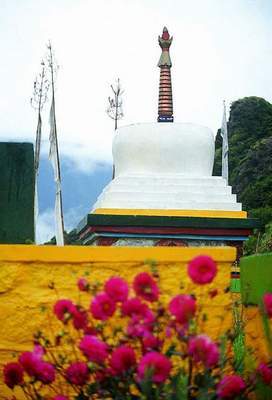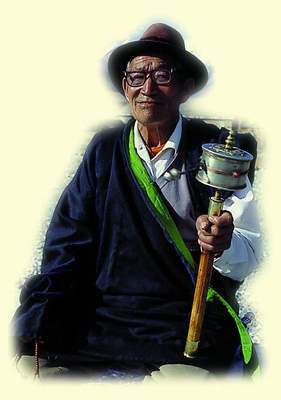The public religious activities in Nyingchi have inherited the common characteristics of Tibetan Buddhism. Differences in customs and traditions of different minority groups have produced a variety of religious sects.
The Gongbo people used to be Bon believers, and the most famous holy mountain of Bon, the Benri Mountain, is located in Nyingchi. It is said that the initiator of Bon religion, Shiro Main'o, cultivated himself in this mountain and attained the Way. During its development, the Bon religion continuously fought with Tibetan Buddhism, and gradually became a part of the culture of Tibetan Buddhism. But in Nyingchi, a remaining polytheism represents the ancestors' religious views. Every fifteenth day of the fourth month of the Tibetan calendar, every household member will walk around the Benri Mountain. One circle around the mountain is about 35 kilometers, and some old people will circle it over 10 times. The people will also visit the one-thousand-year-old trees in the Nyingchi Village. Every village has its own altar, which is shrouded with incense smoke during religious festivals.
The Gelug (Yellow) Sect, being predominant in Gongbo area for many years, has gradually become the major sect in the area. The Red (Nyingma) Sect is influential in the bordering areas. The Nyingchi area now has 97 various religious sites, among which are 49 monasteries, 21 Lhakang (sutra halls) and 27 Rizui (places where monks cultivate themselves). The Yellow Sect has 26 sites, the White (Gagyu) Sect has 9, the Red Sect has 46 and the Bon religion has 5,609 monks and nuns (the nuns number 45). They account for 0.44 percent of the total population of the area. Most peasants and herdsmen are believers of Tibetan Buddhism.
The Gongbo area has three major historically famous monasteries; these are the Demo Monastery, Qangna Monastery and Zhaxi Radain Monastery. They all belong to the Yellow Sect, having a history of about 600 years. These monasteries all house valuable images of Buddha and cultural relics.
Other famous local ancient monasteries include the Dagze Monastery, the Lamaling Monastery (also known as Sangdo Biri), which is uniquely shaped, and Boqug Segyi Lhakang in Nyingchi County, the Barqoide Monastery in Nang County, which has a history of over 1,000 years, the Dordong Monastery in Bome County (also known as Garwalung Monastery, with a history of 600 years), the Renqenpeng Monastery in Medog County, which is located in the White Horse Hill, the Buddhist holy land, with a history of 350 years, the Renqenpeng Monastery, with a history of 570 years, and the Lhagyia Monastery in Gongbo'gyamda County, and the Tarba Monastery in Zaya County, with a history of over 1,000 years.
Having implemented the State's policies for religions in a comprehensive way and having enhanced the administration of monasteries, the government of the Nyingchi area has guaranteed the priests' regular religious activities and the laymen's freedom of religious beliefs. The monasteries have become havens for studying and spreading Buddhism, respecting religious beliefs, and protecting cultural relics and tourism.

A monastery of the Red Sect

An elderly man
